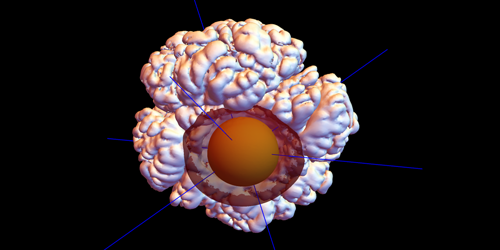
In this dissertation I present the joint analysis of $$\nu_\mu \to \nu_\mu$$ and $$\nu_\mu \to \nu_e$$ oscillation data with an exposure of $$8.85\times10^= \pi/2$$ in the inverted hierarchy at higher than 3$$\sigma$$, and theentire inverted mass hierarchy at the 95\% confidence level. With an 810 km baseline, the combined measurements of muon neutrino disappearance and electron neutrino appearance allow the determination of neutrino oscillation unknowns, namely the mass hierarchy, the octant of the largest neutrino mixing angle, and the CP violating phase. NOvA is a long-baseline neutrino oscillation experiment, which consists of two finely-segmented liquid-scintillator detectors operating 14 mrad off-axis from the NuMI muon neutrino beam. This thesis will discuss the development of the detector response calibration using cosmic ray muon data and its effects on the preliminary charged current quasi-elastic cross-section measurement using beam neutrino data in the NDOS. Furthermore, the neutrino data acquired are being used in the development and implementation of physics analyses, not only for NDOS data, but also for the first NOvA data. These data are also being used in the development of reconstruction and calibration techniques to be used in the Near and Far Detectors. The cosmic ray muon data were used in the commissioning and it is currently being used in testing of detector response. Its goals are to demonstrate that, using the same materials and technologies as the larger NOvA detectors, we more » are able to observe neutrino data from the NuMI beam and cosmic ray muons. In order to carry out the long-term goals of the experiment, the NOvA Near Detector Prototype (NDOS) was built and commissioned at Fermilab. The Near and Far Detectors are constructed off-axis of the NuMI beam line and located at Fermilab and northern Minnesota (electron neutrino appearance maximum), respectively. The NuMI beam line located at Fermilab produces the muon neutrinos for this observation. If you would like more information about NOvA at UCL, please contact Dr.NOvA is a long-baseline neutrino experiment designed to observe the neutrino oscillation phenomenon of muon neutrinos oscillating into electron neutrinos. We also actively participate in the neutrino oscillations analyses themselves.

We are involved in a variety of topics including detector calibration, understanding the neutrino beam flux, and understanding analysis backgrounds. Our group is already relatively large and is now very active on the experiment. The UCL HEP physics group joined the NOvA experiment in 2015 and is only the second institution in the UK to collaborate on NOvA, after Sussex University.

NOvA is currently taking data and has a real chance of making the next big discovery in neutrino physics. NOvA is such an experiment and uses a muon neutrino beam, the NuMI beam, as its source of neutrinos, observes the neutrinos before they have oscillated (changed into electron and tau neutrinos) in a Near detector at Fermilab, and then observes the same beam again after the neutrinos have oscillated in the NOvA Far detector 810km away in Ash River in Minnesota. Neutrinos interact only weakly and so rarely that experiments with giant detectors are needed in order to make the all-important new measurements and discoveries. One very important fact that we currently do not know is which neutrino mass state is heaviest? Is it the third (normal mass hierarchy)? Or is it the second (inverted mass hierarchy)? This is one of the most important questions NOvA is attempting to answer. This is an important definite signal of physics beyond the Standard Model of particle physics and measuring the neutrino's properties could help explain the matter/anti-matter asymmetry of the Universe, provide hints about why we have three generations of particles and possibly open the door to even more strange findings.

Today, we know that there are three types of active neutrino, the electron, muon, and tau neutrino, and that they oscillate between three mass states. It seems the new and startling discoveries never stop where this tiny elusive particle is concerned. Neutrino physics has made great strides in the past twenty years. The NOvA Experiment Leading Efforts to Discover the Neutrino Mass Hierarchy


 0 kommentar(er)
0 kommentar(er)
